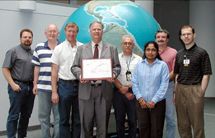Pat Gary: Highlights of 43 Years of Service to NASA Goddard
James Patrick ("Pat") Gary, who passed away on September 15, 2011, spent much of his 43-year NASA career expanding the boundaries of the possible in high-speed computer networking. And this master networker of computers was also a master networker of people — a talent that sustained scores of collaborative projects over the decades and won praise and deep respect from colleagues at NASA, other federal agencies, and the IT industry.
NASA was Pat's first and only job. He came to Goddard Space Flight Center in 1968, fresh out of the Catholic University of America in Washington, D.C., with a B.A. in Mathematics. His first position was as a mathematician and programmer/analyst with the Advanced Development Division (Code 520), helping to automate NASA's data tracking and acquisition network.
Starting in the late 1970s, Pat headed a variety of computing-related sections, groups, and branches within the Goddard organizational ecosystem. However, it was high-speed computer networking and his genius for collaborative technology development that proved to be the winning recipe in his career.
Team Gary
Starting in the late 1980s, a small team of talented network engineers and technologists had coalesced under Pat's leadership, taking the title High End Computer Network (HECN) group (606.1). This team has continually advanced the boundaries of what is
possible with high-performance networks by developing innovative ways to connect high-performance computing equipment into networks both within NASA and externally with
other federal agencies, with universities, and with foreign collaborators.
One of the group's early accomplishments was providing key support to the creation of what came to be called, in 1995, the Center Network Environment (CNE), which linked the Goddard campus over a local area network for the first time.
The group also picked up what turned out to be 14 years of stable funding from the new High Performance Computing and Communications (HPCC) Program, and shifted focus to the exciting new opportunities in high-performance computer networking. This led to the founding of the Science and Engineering Network (SEN) at Goddard as well as the HECN.
In 1996, Pat facilitated Goddard's entry into the Advanced Technology Demonstration Network (ATDnet), a high-performance research network connecting defense-related agencies in the DC region, including the Department of Defense and the National Security Agency. Goddard was the only civilian agency in this network, which offered bandwidth of an unprecedented 622 megabits (million bits) per second.
The networking team at Goddard was welcomed at ATDnet for its well-known expertise in configuring, testing, and troubleshooting networks to squeeze out the best performance possible. The suite of analysis tools developed by the team has grown over the years. These tools are open source and free; some commercial companies have actually incorporated some of the analysis tools into products as familiar as home routers.
Strategic collaborations
Meanwhile, Pat continued to pursue strategic collaborations and foster mutually beneficial relationships. These connections allowed
the Goddard team to obtain early versions of advanced equipment not yet commercially available and access to lightning-fast Internet connectivity — all on a very limited
budget.
The team quickly got a reputation for rigorous testing and analysis of the new networking technology. How fast could it go? How much data could it push? Frequently, the researchers discovered flaws of which the engineers who designed the equipment didn't fully understand the impact.
Here are just a few examples of networking-related projects, technology demonstrations, and collaborations that Pat and his colleagues have been involved in over the decades:
Long-Haul Satellite Internet: In the mid-1990s, Pat involved the team in projects to link computers into continent-spanning wide area networks (WANs) using NASA's currently non-operational Advanced Communications Technology Satellite (ACTS) and other satellites. In one project, a researcher in Japan used a bank of Macintosh computers in his lab to process 2D anatomical image "slices" of the human body and transmit them via a two-satellite hop to the National Library of Medicine in Bethesda, Maryland.
Internet2: In the early 2000's, Pat's team shepherded Goddard onto Internet2, a national high-speed network for universities, federal agencies, national labs, and other research assets. In 2002, the team demonstrated data rates up to 8 gigabits (billion bits) per second to the University of Maryland in College Park at a time when speeds of 100 megabits per second were the norm.
Conference Demos: Over more than a decade, Pat's group has been a major contributor to cutting-edge networking technology demonstrations at the annual Supercomputing (SC) and other conferences. Here are a few highlights:
The technical triumphs are only partly about obtaining access to advanced technology, according to NASA computer scientist James Fischer, a longtime colleague and friend in the Computational and Information Sciences and Technology Office (Code 606). The key ingredient was not just hardware, but the "wetware" of genuine human relationships.
"He turned these relationships into opportunities for Goddard to have better networks and greater functionality," says Fischer. "He was even tempered in the face of resistance to collaboration, which can be a very frustrating process at times. He never showed it."
Pushing the boundaries of the possible — with a lot of help, of course, from his friends. That is how colleagues remember Pat Gary, one of NASA Goddard's best and brightest.
- Daniel Pendick
- SED Web Services Group (606.1)
- NASA Goddard Space Flight Center
- daniel.a.pendick@nasa.gov

Pat Gary's high-performance networking team in 2006, receiving a Group Achievement Honor Award at NASA Goddard. Click to enlarge and see names of group members.
Related Links
High End Computer Network (HECN)
High Performance Computing and Communications (HPCC) Program
Science and Engineering Network (SEN)
The Supercomputing (SC) Conference Series
Advanced Technology Demonstration Network (ATDnet)